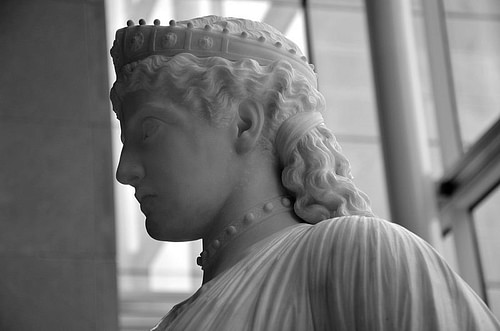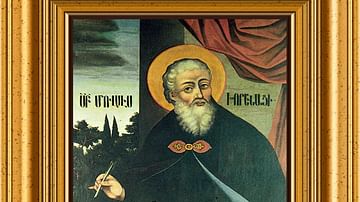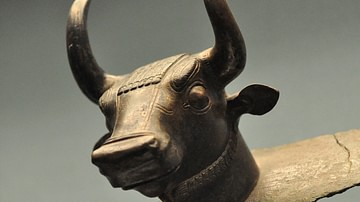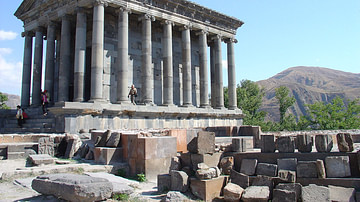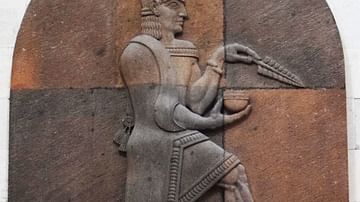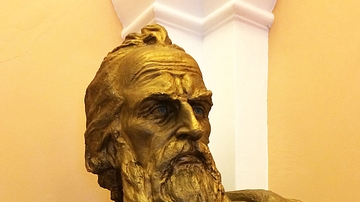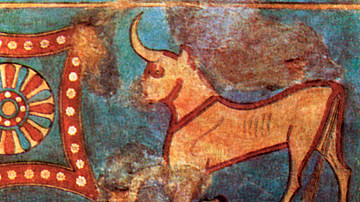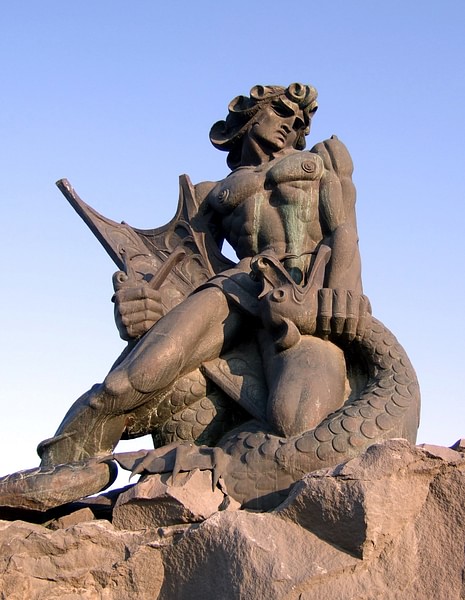
The mythology of ancient Armenia is a rich blend of indigenous traditions with imported ideas from neighbouring cultures and migrating peoples added over the centuries. The legends and stories helped to explain natural phenomena, provide an explanation of the nation's origins, and commemorate key historical events such as wars and invasions.
Origins & Inspirations
The religion of Armenia's first recorded state, Urartu, which was itself a confederation of smaller kingdoms, flourished principally in ancient Armenia from the 9th to 6th century BCE. The Urartu civilization was a unique mix of indigenous, Hurrian, and Mesopotamian gods and symbolism. The pantheon was headed by the trinity of Haldi (god of war), Teisheba (god of storms), and Shivini (the sun god), who were the principal beneficiaries of sacrifices and temples built in their honour. There were others, as attested by a 9th-century BCE inscription discovered in a niche in the mountains near the capital Tushpa (Van). The list, inscribed in duplicate, mentions 79 gods.
There are elements in Armenian mythology similar to the Vedic tradition of India and Egyptian ideas too, most clearly seen in Shivini, who was often represented as a kneeling man holding a winged solar disk, and therefore likely inspired by the Egyptian god of the same association, Ra. The close cultural relations between Urartu and Assyria are also illustrated by the Urartian application of the Assyrian ideograms for the gods Adad and Shamsh to their own gods Teisheba and Shivini respectively. The Tree of Life (in Armenian tsarrn kenats), another motif from Mesopotamian art, appears in various media, typically with a figure standing either side of it and making offerings. The Biblical tradition was another source of inspiration for ancient Armenians seeking to explain their surroundings and history.
As in many other ancient cultures, indigenous gods often represented such important elements or prominent natural features as water, earth, the sun, mountains, caves, and trees. Still other deities were related to ancient animalistic beliefs.
Over time the oral and ancient myths which wove together such diverse cultural threads were recorded in texts and perpetuated orally by lyre-playing bards (gusan) which were, in turn, preserved by even later writers. For example, a portion of an ancient poem recorded by the 5th-century CE historian Movses Khorenatsi describes the birth of the sun god Vahagn (who had replaced Shivini) from a reed in the sea. Unfortunately, though, and despite the best efforts of writers in Late Antiquity, without extended textual evidence from ancient Armenia itself and only an impoverished archaeological record, much of Armenian myth and religion still remains unknown or unexplained. There are small figurines from Urartian sites which are of uncertain significance, for example, of winged females, bird-men, scorpion-men and fish-men. As these hybrid creatures were frequently painted on storeroom interior walls, the most plausible explanation as to their purpose is as protective spirits, but we have no names and no certainty as to their real meaning and purpose. Below, then, are summaries of the most important ancient Armenian myths we know of today.
Hayk & Bel
One of the unique contributions Movses made to Armenian history was his recounting of the foundation myth of the nation (some scholars might say 'inventing'). This is the story of Hayk (Haik) and Bel and places the origins of the Armenian people as the descendants of the biblical Noah via his son Japheth. Hayk, a descendant of Japheth and noted archer (hence his later association with Orion), rebelled one day against Bel the evil and repressive Babylonian tyrant and returned back to his homeland around Mount Ararat in ancient Armenia, where it was thought Noah's ark had come to rest at the end of the great flood. Bel followed Hayk and his relations so that a mighty battle followed in which Bel was killed. Hayk then gave his name to his descendants, the Hay people, and the name of the region of Armenia in the Armenian language, Hayasa. As with most legends, the grain of truth buried in the fiction is that the story of Hayk and Bel may commemorate the actual conflicts between Armenia (then Urartu) and Assyria, especially in the 8th century BCE. Bel, from the Assyrian baal meaning “lord”, represents the evil and oppressive empire of the Assyrians epitomised by such aggressive war-mongers as Tiglath-Pileser III (r. 745-727 BCE) and Sargon II (722-705 BCE) who both besieged Armenian cities.
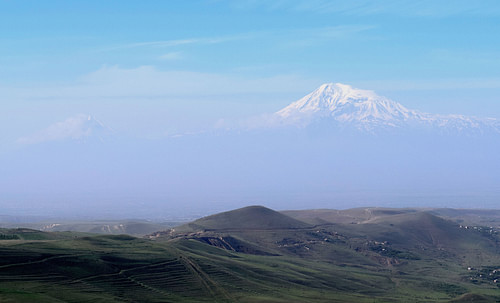
The Hayk and Bel myth is much more than just a pleasant story from the country's military past, as here explained by the political historian R. Pannosian:
In terms of popular perception this story is just as important in modern nationalist thinking as 'objective' history. The myth asserts that Armenians are direct descendants of Noah…The roots of the Armenian nation were thus established around Mount Ararat with Haik and his family. This story, taught to all primary students in Armenian schools around the world, has a number of powerful symbolic components. First, it makes Armenia the cradle of all civilizations since Noah's Ark landed on the 'Armenian' mountain of Ararat. Second, it connects Armenians to the biblical narrative of human development. Third, it infuses a very important element of righteous rebellion against tyranny and oppression (of Babylon). Fourth, it situates freedom, independence and justice at the centre of the nation's origins. And finally, it makes Mount Ararat the national symbol of all Armenians. (51)
Shamiram - Semiramis
Movses Khorenatsi recounts the legend of Shamiram, probably based on the Assyrian queen Semiramis (r. 811-806 BCE), another historical enemy of the Armenian people. One day Shamiram falls in love with the impossibly handsome Armenian king Ara but, being already married and a picture of moral virtue, he shows no interest in the queen and returns to his country. Shamiram's army then follows Ara and, despite orders that no harm should come to the Armenian king, he is killed by a stray arrow. The distraught queen, having lost the object of her affections, then tries to find consolation in wandering the lands of Ara's kingdom. Eventually, she decides to build a city near Lake Van where she will spend the summer months away from here home capital of Nineveh.
Once the splendid new city is finished, Shamiram takes the body of Ara back to her palace where it is kept at the top of a tower so that supernatural dogs (aralezk) might be called to lick him back to life. In one version the dogs perform their miracle and Ara lives once again, but in Movses' version, unfortunately, the dogs never come and so Shamiram, to save face with her people now that the gods have forsaken her, is forced to parade a look-alike to the dead Ara.
The story of Shamiram and Ara is a typical contrast of an evil and immoral foreign ruler against one's own virtuous sovereign and is very similar to the Greek myth of Adonis and the Babylonian Gilgamesh, both of whom reject a goddess' advances with unfortunate consequences. Movses does not, however, paint Shamiram as all bad, for he does credit her with building the ancient Urartian canal of Artamet near Van amongst other architectural and engineering feats, perhaps in acknowledgement that these innovations were assimilated from outside Armenia.
Vahagn & Astghik
Storms on Lake Van were thought to have been caused by the god Vahagn (the Iranian Verethraghna and broadly equivalent to the Greek Hercules) and vishaps, serpents who lived in water. Vahagn was also thought responsible for the Milky Way, known to the ancient Armenians as the “Trail of the Straw-Thief” after he stole kindling from Bel, the enemy of the Ara and Armenian people. The birth of Vahagn and his association with the Sun is here described in a poem preserved for posterity by Movses Khorenatsi:
In travail were heaven and earth,
In travail, too, the purple sea!
The travail held in the sea the small red reed.
Through the hollow of the stalk came forth smoke,
Through the hollow of the stalk came forth flame,
And out of the flame a youth ran!
Fiery hair had he,
Ay, too, he had flaming beard,
And his eyes, they were as suns!
(quoted in Kurkjian, 248)
The next parts of the song (now lost) described Vahagn as a fearless dragon-slayer, hence his other name of Vishabakah, literally translated as “dragon reaper”.
Vahagn's consort was Astghik (aka Astlik), the goddess of beauty and love whose name means “little star” (translated from Beldi, the Syrian goddess). Associated with doves and roses, she had a festival dedicated to her at the beginning of summer. One story involving Astghik tells of her habit of bathing in a stream each night. On one occasion a group of local young men, eager to glimpse the naked goddess, lit a fire on a hill to see Astghik better. The goddess foiled the plan by causing a great mist to settle over the area which henceforth acquired the name “Plain of Mush” after the Armenian word mshoush, meaning mist.
Pokr Mithra - Little Mithra
Pokr Mithra (from the Iranian god of justice Mithra), also called Mihr, according to the oral tradition which is still recited today, is a god who was thought to dwell in a cave which will only open at the end of Time. Inside the cave, Little Mithra sits holding an orb of justice and is served by a raven while he awaits the coming of the Apocalypse. He was also associated with light and truth. The god has a portal carved into the rock face of the acropolis at Van named after him, the Gate of Mithra (Mheri durrn). Traditionally, offerings were made to the gods at such portals of which Van boasts many. It is possible that Mithraism was passed from Persia to the Roman world via legionaries fighting in ancient Armenia during the Parthian Wars of the 1st century CE.
Tork Angelea
Tork Angelea or Tork of Angel is a heroic figure based on Tarkhu, the weather god of Asia Minor. Once again, our source is Movses Khorenatsi, who records an oral legend of a man with great strength who can crush and split rocks before throwing large chunks at his enemies. The legend also tells of Tork scratching designs of eagles onto stone tablets using only his fingernails and throwing stones the size of hills at invading ships on the Black Sea. Perhaps based on an actual conflict in the ancient past, Movses provides the folk etymology of an-gel as “of ferocious men”, and it is interesting to note that the very name of Tarkhu means 'victor' or 'conqueror'. According to Movses, Tork was a descendant of Paskam, the grandson of Hayk.
This article was made possible with generous support from the National Association for Armenian Studies and Research and the Knights of Vartan Fund for Armenian Studies.
